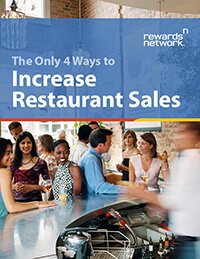No matter what changes in the restaurant industry, one thing never changes. There are still only four ways to increase restaurant sales:
- New Customers
- Repeat Visits
- Increased Spend
- More Table Turns
Download this free eBook today to learn how you can influence each of these four factors to increase restaurant sales.
Excerpt from Introduction:
Earlier this year, something extraordinary happened in the food service industry. For the first time in history, consumer spending on dining out overtook that of grocery sales in the United States. This is incredible news for restaurants and bars yearning to increase sales, but there are challenges that come with this opportunity.
Restaurants have always had to face competition from other establishments with similar menus and price points in their area.
But now, they are also facing grocerants that offer eat-in experiences and other restaurants across the industry spectrum that blur the lines between quick service, fast casual, and even fine dining.
One thing has not changed, however. There are still only four ways to increase restaurant sales: increase the number of new customers, increase frequency of visit for your existing customers, increase the amount of spend per check, and increase the number of table turns or flow-through per day.
In this book, we’ll be looking at each one of these four methods for improving your bottom line, starting with attracting new customers.
Traditionally, restaurants — like the real estate and auto industry — have relied heavily on placements in print media to drive new customers.
Today, newspaper ads or free-standing inserts in local papers and magazines reach less consumers as subscription rates continue to plummet. Direct mail is still a common practice in most industries, but can easily get lost in the overwhelming amount of junk mail your potential customer receives on a daily basis.
And direct mail’s effectiveness is even lower when not sent frequently and consistently, and when not used in combination with a discount or value offer. This is critical to help you break through the thousands of messages consumers receive each day. The common thread for all of these practices is the large expense necessary to execute this type of marketing initiative, as well as the ROI. Often, your return on investment does not justify the time, resources, and energy needed to make a direct mail campaign truly successful.
Programs like Groupon® have recognized this shift, and have sought to offer an incentive to new customers by selling discounted digital deals that they have bulk purchased from restaurants and other businesses. What seemed like a sure driver of traffic at the height of its popularity eventually cost businesses a lot of money upfront (without driving return visits to compensate) and overwhelmingly attracted existing customers, not new ones.
What a lot of restaurants also learned was that offering discounts in bulk undermined the value of their menu, their service, and the experience they had to offer customers — both new and old.
So, how can you drive new customers without devaluing your brand through discounts?
The biggest hurdle for acquiring new customers is simply letting them know you exist. In today’s world, you must be proactive in reaching out to customers. And where are they? The Internet.
It’s long been understood that customers engage the Internet in their dining decisions at a much higher rate than in regard to other industries, with 92% of consumers having searched for a restaurant on their computer (and 81% on their mobile device). What’s more telling, however, is that 75% chose a restaurant based upon those search results.
This puts having an online presence at the top of your marketing needs. It’s true that assembling a website can be an expensive endeavor, but it’s also one of the best tools for establishing your brand, providing great information, and welcoming your new customer before they ever set foot into your restaurant.
And in 2015, it’s a consumer expectation to get an online preview of their dining experience at your restaurant, including up-to-date menus, beautiful photos of your food and environment and an easy way to contact you for reservations or to ask questions.
Building your website out is only half the battle, however. The real work is in letting potential customers know it’s there.
If your website is optimized for search, Google can do quite a bit of that work for you, but there are many ways to get your name out there and drive even more traffic through your doors.
Maintaining a social media presence on Facebook, Twitter, or Instagram is one way to advertise through modern word-of-mouth the type of experience you have to offer. In our recent survey, 46% of consumers said recommendations from others, both on- and offline, was their primary method for finding restaurants.
Sharing photos of your specials and talking up your most popular dishes is a great way to drive interest. Also, make sure your listing at Yelp or other socially-driven consumer sites is up-to-date and complete with photos and content that will stand out in a sea of search results.
*All statistics footnoted in eBook appendix.
